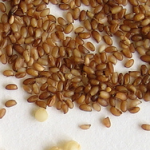Gluten Free Flour Guide
You have been diagnosed with Celiac disease or gluten intolerance (also called sprue, gluten enteropathy or gluten-sensitive enteropathy), now what?

If you think your baking life is all over now that you can’t use traditional flours, think again. While gluten-free flours certainly do take some time to learn to work with they are every bit as versatile as the gluten flours and usually come packed with extra nutrition to boot.
This gluten-free flour guide can help you navigate the world of gluten-free flours. I’ve included a brief description of the gluten-free flours and a recipe or two to get you started.
Many of the following recipes contain sugars (and you may know I’m not a big fan of sugar), but I’m also not a big fan of grains (especially the gluten grains). Consider kicking the gluten grains as a first step and then moving on to kick sugar out of your life (see my 30 Sugar Free Days Program).
Almond Flour
 Almond flour is made from almonds (I know, it’s obvious) and is a great way to get extra protein and good fats into a meal. The flour itself is denser than grain flowers and adds a lot of stability and “meatiness” to a recipe. Almond flour is perfect for baked goods and the cherry-like flavor means less need for added sugars.
Almond flour is made from almonds (I know, it’s obvious) and is a great way to get extra protein and good fats into a meal. The flour itself is denser than grain flowers and adds a lot of stability and “meatiness” to a recipe. Almond flour is perfect for baked goods and the cherry-like flavor means less need for added sugars.
- Almond Flour Recipes (Elana wrote the book on almond flour)
- Almond Flour and Rice Pie Crust
- Gluten Free Almond Flour Pizza Crust
Amaranth Flour
 Amaranth is a beautiful plant that produces millions of tiny seeds. These seeds can be ground up and used as a flour; the leaves of the amaranth plant are also used as food. While there are over 60 different kinds of amaranth only a few are found in our stores. Amaranth seeds and flour are very high in protein and they have a distinct nutty flavor. You can bake with the flour or add the cooked or uncooked seed to most recipes.
Amaranth is a beautiful plant that produces millions of tiny seeds. These seeds can be ground up and used as a flour; the leaves of the amaranth plant are also used as food. While there are over 60 different kinds of amaranth only a few are found in our stores. Amaranth seeds and flour are very high in protein and they have a distinct nutty flavor. You can bake with the flour or add the cooked or uncooked seed to most recipes.
Buckwheat Flour
 Buckwheat has a strong flavor that could be described as nutty or dark. It is a good idea to mix it with other grains such as corn or rice flour to buffer the taste. Like amaranth and quinoa, this grain is packed full of amino acids; it is also high in fiber.
Buckwheat has a strong flavor that could be described as nutty or dark. It is a good idea to mix it with other grains such as corn or rice flour to buffer the taste. Like amaranth and quinoa, this grain is packed full of amino acids; it is also high in fiber.
- Brown Rice & Buckwheat Sandwich Bread
- Gluten-Free Rosemary-Thyme Dinner Rolls
- Buckwheat Waffles
- Buckwheat Sweet Potato Quick Bread
Carob Flour
 Carob seed pods come from a tree and the pods are ground to create a flour. The taste can best be described as “chocolate like,” but carob has a natural sweetness that cocoa (baking chocolate) doesn’t
Carob seed pods come from a tree and the pods are ground to create a flour. The taste can best be described as “chocolate like,” but carob has a natural sweetness that cocoa (baking chocolate) doesn’t
Coconut Flour
 The amazing coconut has so many uses and coconut flour adds a delightful taste to almost any baked food. While you might think that coconut flour would have a strong coconutty flavor, it doesn’t and that is why you can use it in foods such as pizza crust.
The amazing coconut has so many uses and coconut flour adds a delightful taste to almost any baked food. While you might think that coconut flour would have a strong coconutty flavor, it doesn’t and that is why you can use it in foods such as pizza crust.
- Herbed Gluten Free Coconut Flour Pizza Crust
- Gluten Free Dinner Rolls
- Gluten-Free Pasta Recipe (check out the substitutions part of this recipe)
Corn Flour
 Corn is so versatile and is used in so many dishes that it hardly needs an introduction. I would caution anyone with Celiac disease to watch out for corn because it is another common food allergy.
Corn is so versatile and is used in so many dishes that it hardly needs an introduction. I would caution anyone with Celiac disease to watch out for corn because it is another common food allergy.
Garbanzo Bean Flour
 The garbanzo bean (otherwise known as chickpea) is a great source of vitamins and minerals. When the bean is ground it creates a flour that is similar to almond flour (a little more dense than regular flours). Garbanzo beans do have a distinct flavor but I find they mix in well with other flours and add a slightly nutty flavor.
The garbanzo bean (otherwise known as chickpea) is a great source of vitamins and minerals. When the bean is ground it creates a flour that is similar to almond flour (a little more dense than regular flours). Garbanzo beans do have a distinct flavor but I find they mix in well with other flours and add a slightly nutty flavor.
Millet Flour
 Millet has been known for a long time as a bird feed. These tiny yellow seeds make a flour that is light and airy. There is a slight taste to millet but nothing you have to work around (like buckwheat). Millet flour does not stick together well so you need to use a binder (see below).
Millet has been known for a long time as a bird feed. These tiny yellow seeds make a flour that is light and airy. There is a slight taste to millet but nothing you have to work around (like buckwheat). Millet flour does not stick together well so you need to use a binder (see below).
Potato Flour
 I like to add potato flour to a number of dishes; it is great as a thickener in soups. As a baking flour it adds a smooth taste to most dishes.
I like to add potato flour to a number of dishes; it is great as a thickener in soups. As a baking flour it adds a smooth taste to most dishes.
Quinoa Flour
 Quinoa has a distinct flavor but one that most people find enjoyable. Like millet flour, you need to use some binder (see below) to help it stay together when you are baking with it. Quinoa is one of the healthiest of the non-grain grains and you should experiment and use it often.
Quinoa has a distinct flavor but one that most people find enjoyable. Like millet flour, you need to use some binder (see below) to help it stay together when you are baking with it. Quinoa is one of the healthiest of the non-grain grains and you should experiment and use it often.
Rice Flour
 You can buy rice flour or you can use the whole cooked grain in many baked foods. When I make waffles I use whole cooked rice as part of the recipe and the grains just disappear in the waffle maker, leaving a slightly chewy texture. Rice flour is light and can be added to almost any baked good.
You can buy rice flour or you can use the whole cooked grain in many baked foods. When I make waffles I use whole cooked rice as part of the recipe and the grains just disappear in the waffle maker, leaving a slightly chewy texture. Rice flour is light and can be added to almost any baked good.
Sorghum Flour
 Sorghum flour is another flour with a distinctive flavor. I think it is best used when combined with other flours.
Sorghum flour is another flour with a distinctive flavor. I think it is best used when combined with other flours.
Soy (soya) Flour
 Similar to garbanzo flour, soy flour is a light flour that adds a high amount of protein to any meal. It works well with many other non-gluten grains.
Similar to garbanzo flour, soy flour is a light flour that adds a high amount of protein to any meal. It works well with many other non-gluten grains.
Sweet Chestnut Flour
 I haven’t used chestnut flour, but many people use it in baked goods such as cookies and pancakes.
I haven’t used chestnut flour, but many people use it in baked goods such as cookies and pancakes.
- Amy’s Gluten-Free Chestnut Flour Mix for making cookies and other baked goods.
- Sweet Chestnut Pancakes
Teff Flour
 Teff is the tiniest grain that is used for food. The word Teff means “lost” – supposedly because it is so easy to lose these tiny grains. Teff is so small that it can be added to many baked goods without even grinding it. The taste of Teff can best be described as malty, try mixing a small amount into your next baked food to make it an adventure.
Teff is the tiniest grain that is used for food. The word Teff means “lost” – supposedly because it is so easy to lose these tiny grains. Teff is so small that it can be added to many baked goods without even grinding it. The taste of Teff can best be described as malty, try mixing a small amount into your next baked food to make it an adventure.
Thickeners and binders
If you are going to use grains without gluten, then you often need something to hold them together (gluten means “glue”). The following are good replacements for gluten:
- Tapioca (cassava)
- Arrowroot
- Xanthan gum
- Taro flour
- Guar gum
Feel Better
Most people who start eating a non-gluten diet feel much better than they have in years. This is a big transition, but once you learn the tricks it gets much easier.
Do you have some great recipes of your own? Leave them in the comment section below (or provide us with a link to the recipe).
I also have a guide to cooking with non-gluten grains, check it out here: Cooking With Non-Gluten Grains.










is nuts and fat free yogurts ok to eat
Yes, those are okay.